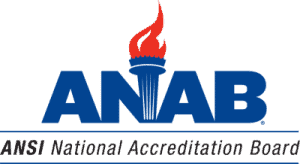What Is Reaccreditation?

To understand reaccreditation, one must first understand accreditation.
What is Accreditation?
Accreditation is an independent evaluation of conformity assessment bodies (CABs) against recognized standards to carry out specific activities to ensure their integrity, impartiality, and competence. Accreditation is scope specific.
Initial Accreditation is a term often used in relation to when an organization or CAB obtains its accreditation for the first time.
How Long Does Accreditation Last?
The accreditation cycle allowed under ISO/IEC 17011, the standard that specifies requirements for the competence, consistent operation, and impartiality of accreditation bodies, shall not be longer than five years. Depending on the accreditation program, ANAB’s accreditation cycles can range from two to five years.
How to Maintain Accreditation
It is important to note that oversight of the CAB is maintained throughout the accreditation cycle through various surveillance activities.
CABs such as laboratories, inspection bodies, forensic service providers, product/personnel/management systems certification bodies, and greenhouse gas validation and verification bodies are subject to ongoing verification of competence for their scope of accreditation through document reviews, assessments, and witnessing to ensure conformance with the specified accreditation criteria.
ANAB develops what is called an assessment program for each CAB, which identifies oversight activities that are planned over the accreditation cycle based on their locations and scope of accreditation. Assessing the competence of a CAB involves reviewing the operations of the CAB, including the competence of the personnel, the validity of the conformity assessment methodology, and the validity of the conformity assessment results.
Accreditation cycle is marked by: Initial Accreditation—Continued Oversight—Reaccreditation—Continued Oversight—Reaccreditation. That goes on until CAB withdraws of loses its accreditation status. Accreditation and reaccreditation mark the first accreditation cycle, reaccreditation to reaccreditation mark all subsequent accreditation cycles.
In the years between, during oversight, requirements are sampled based on pre-defined criteria.
It is important to note that although most of the time assessment related activities are planned and scheduled in advance, ANAB reserves the right to conduct unscheduled assessments outside of the expected assessments. Reasons for this increased monitoring of activity can be because of, but not limited to:
- Significant organization changes
- Requested scope changes
- Multiple NCRs and/or complaints in a specific program or process
- Relationships that cause a real or perceived conflict of interest
- Other conditions as deemed appropriate.
What is Reaccreditation?
Reaccreditation is part of this continued oversight, but the important key factor is that during reaccreditation, conformance to all requirements of the accreditation and the entire scope of accreditation are being assessed. In essence, reaccreditation is like initial accreditation, just with an organization that already has been accredited. Reaccreditation falls on the last year of the accreditation cycle. If reaccreditation is not completed, the CAB’s certificate of accreditation will expire.
The Accreditation Process Illustrated

There are additional examples of the accreditation processes for Management Systems and Laboratory Accreditation. Other processes may be used for other programs.
Decision on Accreditation and Reaccreditation, Accreditation Decision
The decision on accreditation occurs at both initial accreditation and reaccreditation. The decision could be made by either a committee(s) that includes people with expert knowledge in the area of accreditation or an individual; the important factor being, in addition to competence, decision makers are different from those who carried out the assessment activity.
Even though these individual or individuals were not part of the assessment activities, they must be provided with sufficient information for the decision makers to be satisfied that the relevant requirements for accreditation have been fulfilled as well as to ensure the integrity of the overall process. This information includes (as per ISO/IEC 17011), but is not limited to:
- unique identification of the conformity assessment body;
- date(s) and type(s) of assessment(s) (e.g. initial, reassessment);
- name(s) of the assessor(s) and, if applicable, technical expert(s) involved in the assessment;
- unique identification of all locations assessed;
- scope of accreditation that was assessed;
- the assessment report(s);
- a statement on the adequacy of the organization and procedures adopted by the conformity assessment body to give confidence in its competence, as determined through its fulfilment of the requirements for accreditation;
- sufficient information to demonstrate the satisfactory response to all nonconformities;
- where relevant, any further information that may assist in determining the competence of the conformity assessment body through conformity with requirements;
- where appropriate, a recommendation as to the accreditation decision for the proposed scope.
Accreditation and reaccreditation can be rewarding and fulfilling processes for CABs. There are many benefits to accreditation. It is a means to reduce costs, eliminate trade barriers, and more. It also assures that accredited organizations are competent and reliable.
Visit the ANAB website to learn more about how to apply or reapply for accreditation or to request a quote.






